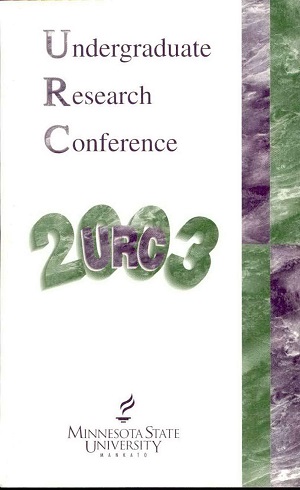The Influence of Solar Ultraviolet-B Radiation on Phenylpropanoid Concentrations and Ferric-Reducing Ability in Avena Sativa
Location
CSU
Student's Major
Biological Sciences
Student's College
Science, Engineering and Technology
Mentor's Name
Christopher Ruhland
Mentor's Department
Biological Sciences
Mentor's College
Science, Engineering and Technology
Description
The result of high levels of ultraviolet -B radiation on plants provides evidence for an increase in plant production of non-enzymatic antioxidant phenylpropanoids in plant tissue. This UV-B radiation enables the production of damaging oxygen radicals which may lead to loss of membrane integrity and reductions in photosynthesis. The hypothesis of this research is that increased phenylpropanoid concentrations may lead to higher levels of oxygen scavenging in methanol extracts of plant foliage as assessed with the Ferric Reducing/Antioxidant Power (ERA?) assay. Twenty Avena sativa plants were grown under treatments that either transmitted near-ambient levels of UV-B or reduced levels of UV-B during the summer of 2002. Plants were harvested after 49 days and assessed spectrophotometrically. These samples were then assessed using the FRAP assay to determine the reducing ability between the two treatments. There was no significant difference between the treatments. More research is necessary to assess the relative importance of plant phenylpropanoids as possible antioxidant compounds, and their relative role in reducing UV-B-induced damage.
The Influence of Solar Ultraviolet-B Radiation on Phenylpropanoid Concentrations and Ferric-Reducing Ability in Avena Sativa
CSU
The result of high levels of ultraviolet -B radiation on plants provides evidence for an increase in plant production of non-enzymatic antioxidant phenylpropanoids in plant tissue. This UV-B radiation enables the production of damaging oxygen radicals which may lead to loss of membrane integrity and reductions in photosynthesis. The hypothesis of this research is that increased phenylpropanoid concentrations may lead to higher levels of oxygen scavenging in methanol extracts of plant foliage as assessed with the Ferric Reducing/Antioxidant Power (ERA?) assay. Twenty Avena sativa plants were grown under treatments that either transmitted near-ambient levels of UV-B or reduced levels of UV-B during the summer of 2002. Plants were harvested after 49 days and assessed spectrophotometrically. These samples were then assessed using the FRAP assay to determine the reducing ability between the two treatments. There was no significant difference between the treatments. More research is necessary to assess the relative importance of plant phenylpropanoids as possible antioxidant compounds, and their relative role in reducing UV-B-induced damage.



